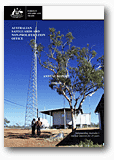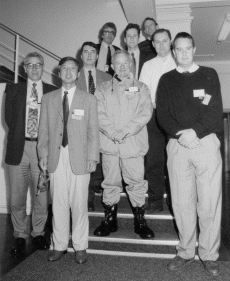


Annual Report 1998-99 |
 |
PROGRAM ACTIVITIES
ASNO’s activities in 1998–99 are described and evaluated in the following sections.
Activities are described in relation to particular tasks, and grouped according to the output to which they relate (see summary of outcomes and outputs).
OUTPUT D
Operation of the national authority for implementation of the CWC, including contribution to effective international implementation of the CWC, particularly in Australia’s immediate region.
Milestone D1
Effective performance as the national focal point for liaison with the OPCW and other States Parties in relation to the fulfilment of Australia’s obligations under the CWC.
Activities
Dealings with the OPCW
In accordance with Australia’s obligations under the CWC, ASNO prepared and submitted routine declarations and notifications to the Technical Secretariat of the OPCW during the year, and facilitated the conduct of two routine on-site OPCW inspections.
In September and October 1998, ASNO submitted routine CWC Article VI declarations on activities anticipated during 1999 for a total of 14 facilities which work with Scheduled chemicals. In March 1999, declarations were submitted which reported work during 1998 in 63 facilities with CWC-relevant activities. These declarations were compiled using information gathered through the operation of the Chemical Weapons (Prohibition) Act 1994, and information on imports and exports of Scheduled chemicals obtained from Customs data, export-licensing records and also through extensive industry surveys.
During the year ASNO facilitated two routine OPCW inspections in Australia. The first, a systematic re-inspection of Australia’s single declarable Schedule 1 facility - the Defence Science and Technology Organisation (DSTO) Aeronautical and Maritime Research Laboratories (AMRL) in Maribyrnong, Victoria - took place from 18 to 21 August 1998. In accordance with Convention requirements, the inspection sought to verify the information provided in Australia’s declarations with respect to this facility, and that Schedule 1 chemicals were not being diverted or used in undeclared activities. Following the inspection, an ASNO officer met with senior OPCW Technical Secretariat officials in The Hague to clarify the perimeter of the declared facility and to discuss possible refinement of inspection procedures, in order to enhance the efficiency of OPCW inspections.
 |
|
Photograph courtesy of DSTO |
The second inspection took place from 30 September to 1 October 1998 at a commercial facility producing a Schedule 3 chemical in significant quantities. Inspectors checked consistency of activities at the site with declarations and confirmed the absence of any Schedule 1 chemical at the site. The OPCW agreed with the assessments of both ASNO and the facility operator that a facility agreement was not warranted in this case.
Other declarations and notifications to the OPCW during 1998–99 included: seven notifications of proposed imports of Schedule 1 chemicals; notifications in relation to approval of inspectors designated to Australia; and as a means of promoting transparency and consistency amongst States Parties, details of the criteria which Australia had used for reporting Schedule 2 and 3 aggregate national data and for making plant site declarations. The latter information was subsequently included in Reports by the Director General of the Technical Secretariat to both the thirteenth and fifteenth sessions of the OPCW Executive Council.
Since entry into force, the Schedule 1 transfer provisions of the Convention have had the unintended consequence of inhibiting legitimate access to saxitoxin, a Schedule 1 chemical frequently used for medical and pharmacological purposes. Australian research projects requiring small quantities of saxitoxin have been hampered by these provisions. Therefore Australia has been at the forefront of attempts to develop an internationally acceptable solution to resolve this problem. To this end, Dr Shaw, Head of ASNO’s CWC Implementation Section, actively participated in a technical seminar convened by the OPCW and held in The Hague from 24 to 25 September 1998, which aimed to provide the Technical Secretariat with a clearer understanding of the global extent of saxitoxin use.
Following an invitation from the OPCW Technical Secretariat, Dr Shaw participated in the second OPCW declaration assistance network workshop held in The Hague from 30 to 31 March 1999. The aim of the network is to establish an international group of professionals, which the OPCW can draw upon to provide on-site support to national authorities in the completion of their declarations. Such professionals are selected by the Technical Secretariat on the basis of their competence and expertise in preparing OPCW declarations.
Immediately following the declaration assistance network workshop, and at the request of ISD, Dr Shaw participated in OPCW-convened consultations directed towards developing low concentration guidelines for Schedule 2 and 3 declarations. These consultations are ongoing.
In addition, ASNO was invited by the OPCW Technical Secretariat to present a paper to the inaugural Annual Meeting of National Authorities and Chemical Industry, held in The Hague from 26 to 27 June 1999. The aim of such international meetings is to promote transparency and cooperation between national authorities, including regional cooperation, as a means of improving the effectiveness of national implementation of the Convention. Drawing upon practical experiences, Australia’s presentation focused on improving methods for collecting and disseminating import and export data relating to international transfers of Scheduled chemicals. Following on from this meeting, ASNO actively participated in the OPCW Fourth Conference of States Parties.
Dealings with other States Parties
ASNO liaised extensively with counterparts in Canada, the United States and the United Kingdom during the year in connection with transfers of Schedule 1 chemicals, including in relation to efforts to resolve the problems associated with access to saxitoxin for use in medical/diagnostic activities. Bilateral consultations with the New Zealand national authority took place for the first time. Together with DSTO, ASNO was also able to share practical CWC implementation experiences with the national authority of Indonesia, leading to a request for further assistance. In cooperation with DSTO and DFAT, work towards developing an improved site selection methodology for Schedule 3 inspections commenced with counterparts in Japan and the Republic of Korea. Finally, ASNO and DFAT have established the basis for an assistance program with the Government of Vietnam for practical implementation of the CWC.
Performance Assessment
By providing accurate and timely declarations and notifications to the OPCW, ASNO has ensured that Australia has maintained a strong record of performance in meeting its CWC commitments. Recognition of excellence is reflected in invitations from the OPCW to participate in the international declaration assistance network and to present at the inaugural Annual Meeting of National Authorities, and from regional countries to assist in implementing CWC obligations.
The two inspections conducted by the OPCW during the year proceeded smoothly. While inspectors were able to fulfil their mandate, ASNO was able to ensure that legitimate commercial and other activities were not unduly affected by these exercises. Inspection reports reflected well upon the performance of ASNO in effectively facilitating these inspections.
On 15 January 1999, the Executive Council of the OPCW recommended a change to the Convention to facilitate transfers of saxitoxin for medical/diagnostic purposes. ASNO played a key role in achieving this satisfactory outcome.
Milestone D2
Activities and facilities in Australia relevant to CWC declarations are identified and the systems of permits and notifications established by the Chemical Weapons (Prohibition) Act 1994, and Regulation 5J of the Customs (Prohibited Imports) Regulations are operated effectively and/or amended as necessary.
Activities
Permits and Notifications
During the year seven additional facilities were identified by ASNO as requiring permits under the Act, including six working with Schedule 1 and one working with Schedule 2 chemicals. In addition, three facilities previously holding permits re-applied for Schedule 2 permits during the year.
Table 5. Permits for CWC Scheduled Chemical Facilities held at 30 June 1999.
| Subsection | 19(4) | 19(5) | 19(6) | 18(1) | 18(1) |
| Facility |
Schedule 1 |
Schedule 1 |
Schedule 1 |
Schedule 2 |
Schedule 3 |
| Type |
protective facility |
research facility |
consumption facility |
processing facility |
production facility |
| Number | 1 | 7 | 2 | 11 | 4 |
Valid notifications under subsection 29(1) were received from 48 companies in relation to production of discrete organic chemicals during 1998.
ASNO provided reminders to each company or organisation of their obligations to ensure legislative requirements were met.
Legislation
The focus of ASNO’s work in this area during 1998–99 has been the development of a package of amendments to the Chemical Weapons (Prohibition) Regulations in light of amendments to the Chemical Weapons (Prohibition) Act, which received Royal assent on 6 April 1998. In the main, these amendments aim to simplify compliance obligations for facilities requiring a permit.
Import Survey
While individual licenses are required for all Schedule 1 imports, so far Australia has not required importers to obtain licences for Schedule 2 and Schedule 3 chemicals. At entry into force of the Convention, it was envisaged that import declaration requirements could be met by compiling data from trade statistics collected by the Australian Customs Service. Unfortunately, trade statistics have proven unreliable, resulting in the need for ASNO to conduct annual industry surveys. In order to ensure that declarations are accurate and complete, it has been necessary to distribute these surveys widely, with over 220 importers surveyed during the year, even though very few companies actually import Schedule 2 and 3 chemicals (less than 25 companies were identified during 1998–99). This process has proven administratively cumbersome and time consuming, both for industry and ASNO, while providing no guarantee that all imports have been accounted for.
Proposed amendments to Customs (Prohibited Imports) Regulations
Minor amendments to Regulation 5J of the Customs (Prohibited Imports) Regulations are necessary to implement a recent OPCW Executive Council decision with respect to international trade in the CWC Schedule 1 chemical saxitoxin, and to regulate the import of CWC Schedule 2 and 3 chemicals. The need to regulate Schedule 2 and 3 chemicals arises because as from April 2000 trade in Schedule 2 chemicals will be restricted to CWC States Parties, while similar trade restrictions may also extend to Schedule 3 chemicals from April 2002. Such amendments will not only clarify the legislative basis for Australia collecting the international trade data needed to fulfil Treaty obligations, but will also ensure Australia does not breach the Convention through importing Schedule 2 chemicals from non-States Parties. In doing so, the amendment should significantly reduce the burden on industry by monitoring/regulating only the actual importers of Scheduled chemicals.
Performance Assessment
The system of permits and notifications operated satisfactorily during 1998–99. ASNO was very proactive in assisting Australian industry to make its various declarations. Australian industry has expressed strong appreciation for the ASNO outreach program which seeks to better inform them about CWC implementation and implications.
The Chemical Weapons (Prohibition) Amendment Regulations 1998 received Royal assent on 17 December 1998.
The Australian Customs Service has agreed to amend Regulation 5J of the Customs (Prohibited Imports) Regulations, as requested by ASNO.